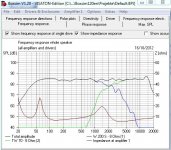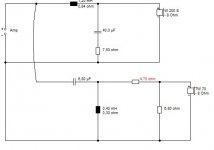2 threads on the same subject started by the same member merged 
High resolution and passive crossover don't go together.

High resolution and passive crossover don't go together.
Passive crossovers...
I see few projects here that feature very expensive drivers and a lot of time designing and making boxes. Then they use passive crossovers which are convenient but are plagued by wrecking the damping factor of the amplifier thus causing distortion especially at low frequencies that causes that sloppy bass everyone is trying to get rid of here. Some confuse this distortion with loud bass. Overall distortion can be measured in the order of 0.1% and up with passives although a nice couple of op amps are in the 0.0001 region with unity gain could that be a thousand times better? Perhaps theoretically but you have to agree that they do have a lot lower distortion!
I see few projects here that feature very expensive drivers and a lot of time designing and making boxes. Then they use passive crossovers which are convenient but are plagued by wrecking the damping factor of the amplifier thus causing distortion especially at low frequencies that causes that sloppy bass everyone is trying to get rid of here. Some confuse this distortion with loud bass. Overall distortion can be measured in the order of 0.1% and up with passives although a nice couple of op amps are in the 0.0001 region with unity gain could that be a thousand times better? Perhaps theoretically but you have to agree that they do have a lot lower distortion!
Why?
Execution is very important. All too many active systems are only good. A very well executed passive system can outperform an only good active system.
Your statement is far to general to be anywhere near true.
dave
Execution is very important. All too many active systems are only good. A very well executed passive system can outperform an only good active system.
Your statement is far to general to be anywhere near true.
dave
Why would you pit a good active system against a very good passive system. Agreed active systems still need care but passive crossovers are ultimately flawed so will never reach the performance levels of well implemented actives no matter how good it is. Please tell me Sir, in what way do passive crossovers have an advantage of active?
but passive crossovers are ultimately flawed so will never reach the performance levels of well implemented actives...
This is blatantly false.
Ultimately flawed!? You haven't heard a good pair apparently.
Later,
Wolf
Agreed active systems still need care but passive crossovers are ultimately flawed so will never reach the performance levels of well implemented actives no matter how good it is. Please tell me Sir, in what way do passive crossovers have an advantage of active?
Take a well selected system with a simple series XO. It has a degree of self-compensation because of the interaction of all drivers and XO together that no active system can accomplish.
Active systems have some serious advantages, but also downsides. The advantages are not enuff to give them blanket superiority.
Each system has to be considered on its merits.
I admit that most of my systems are active (almost always with no intervening electronics to add their own layer of grunge), but i have built at least one passive system that really opened my eyes to the possibilities.
dave
Yes, an op amp is thousand times better, but an active crossover is only few percent better than a passive.
Yes, an op amp is thousand times better......
why op amp ?
but really, messing with multiple amps, and possibly even different ones, its not just a simple matter like plugging in a few cables
Example of a woofer at 100 Hz:
Active crossover: 1 % distortion
Passive crossover: 1.03 % distortion
The difference is negligible. An active solution has certainly not 0.001 % distortion.
Active crossover: 1 % distortion
Passive crossover: 1.03 % distortion
The difference is negligible. An active solution has certainly not 0.001 % distortion.
I see few projects here that feature very expensive drivers and a lot of time designing and making boxes. Then they use passive crossovers which are convenient but are plagued by wrecking the damping factor of the amplifier thus causing distortion especially at low frequencies that causes that sloppy bass everyone is trying to get rid of here. Some confuse this distortion with loud bass.
Overall distortion can be measured in the order of 0.1% and up with passives although a nice couple of op amps are in the 0.0001 region with unity gain could that be a thousand times better? Perhaps theoretically but you have to agree that they do have a lot lower distortion!
Yup, a couple of breathless and innaccurate ideas there, sorry. Passive crossovers have NO PROBLEMS with bass response or damping factor. The issues are at the much higher crossover point.
Why? Well look at the circuit. The bass coil really only acts at HIGHER frequencies to slope the response down. At 100Hz it is virtually transparent to the signal and has little effect on bass damping. The cabinet dimensions and room acoustics play a bigger part. You did know that you can get a tight bass with a valve amplifier which has an output impedance of several ohms didn't you?
Op amps look very nice on sine wave, but you face Class B crossover distortion and transient slew rate issues. A simple discrete transistor preamp is the preferred solution in the new Marantz 6004 amplifier, replacing an opamp in the 6003 model. So what do you know? 😀
Better drivers with advanced magnets, underhung voice coils and copper pole pieces and vented magnets are all nice features which you will pay for. The skill is to balance the performance to a price point really. Personally, I find reducing midbass cone breakup and avoiding intermodulation distortion from the tweeter resonance most interesting with passive crossovers. You can really hear the difference when it's well done, and for that you need to know the drivers like the back of your hand. 😎
Attachments
Passive crossovers have NO PROBLEMS with bass response or damping factor.
not that simple either
but I will take the opportunity to say I think of passive crossovers as a blessing
meaning that most of what we know about speaker design today would not have been possible without
I think it IS that simple, tinitus. 😀
The bass coil in a passive crossover is not the culprit with sloppy bass. Far more to do with room acoustics, box design and Q and room damping. Room gain is an enormous factor. You really won't get good bass with a big speaker in a small lively room. It's gonna BOOM!
Why does no-one ever GET IT with Steen Duelund's simple thought model? 😕
Lead a horse to water, an all that...🙂
The bass coil in a passive crossover is not the culprit with sloppy bass. Far more to do with room acoustics, box design and Q and room damping. Room gain is an enormous factor. You really won't get good bass with a big speaker in a small lively room. It's gonna BOOM!
Why does no-one ever GET IT with Steen Duelund's simple thought model? 😕
An externally hosted image should be here but it was not working when we last tested it.
Lead a horse to water, an all that...🙂
damping factor and "sloppy bass" has nothing to do with "distortion" from passive components since, by definition, linear and time-invariant systems, such as those by passive devices can NOT introduce distortion on sinewaves but only phase delay and attenuation.
I think it IS that simple, tinitus. 😀
The bass coil in a passive crossover is not the culprit with sloppy bass.
Why does no-one ever GET IT with Steen Duelund's simple thought model? 😕
Steen Duelund was indeed exstremely enthusiastic, and very bright
but not always right
but since you dont know it all yet 🙄 back to building speakers 😀
btw, now you mention Steen Duelund
he spent many years trying to devellop better crossover components, and drivers
because he believed it would be impossible to build his dream speakers with what was available
unfortunately a fatal decision
I think it IS that simple, tinitus. 😀
The bass coil in a passive crossover is not the culprit with sloppy bass. Far more to do with room acoustics, box design and Q and room damping. Room gain is an enormous factor. You really won't get good bass with a big speaker in a small lively room. It's gonna BOOM!
Then please explain the much tighter and more detailed bass I got when I replaced the passive xover on my speakers with an active one. Same room, same placement, same box, same amp.
Admittedly the active xover has 24dB L-R slopes as opposed to the 12dB original but most of the audible difference is well below the unchanged 1.2k xover point.
Then please explain the much tighter and more detailed bass I got when I replaced the passive xover on my speakers with an active one. Same room, same placement, same box, same amp.
Same listener with the same brain. Your perceptual results are not necessarily reality. Did something change? - probably. Was it an improvement? - maybe yes, maybe no. Did it sound better to you? Sounds like it did. Could the two have been made to be equivalent matching either one? Yes.
Passive, active, done correctly they are indistinguishable. Done wrong and both can be a disaster. Active excels sometimes, but until recently active was just too expensive for anything but DIY. These days, DSP is so cheap that it makes more sense, but its still more expensive (two amps versus one.)
I would possibly agree if it weren't for my friend who noticed the change almost immediately without knowing anything about the change I made.
It took him about 5 minutes to notice any change after I swapped op amps in my crossover at later time.
It took him about 5 minutes to notice any change after I swapped op amps in my crossover at later time.
Did it sound better to you? Sounds like it did.
only mentioned that bass was improved
but it could just as well be amp related
or the box isnt optimal
lots of other things could have influence
but I suppose active will most likely give some advantage if it replaces a poorly designed passive crossover
and only if its a well designed speaker, as such
if the whole speaker is sick, active wont cure it
Couldn't hear much difference in the treble, the amp in question is an MC2 Audio MC450.
The amp for the treble is now an MC2 Audio T500.
As I said box, room, placement and xover point remained identical.
The amp for the treble is now an MC2 Audio T500.
As I said box, room, placement and xover point remained identical.
- Status
- Not open for further replies.
- Home
- Loudspeakers
- Multi-Way
- Active vrs passive

